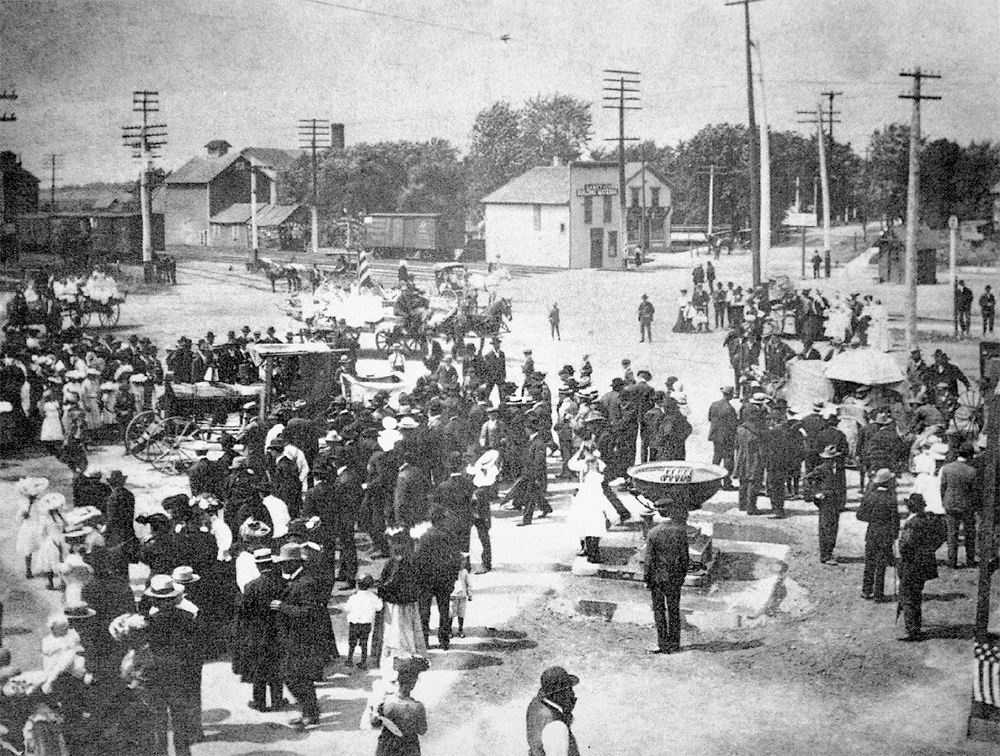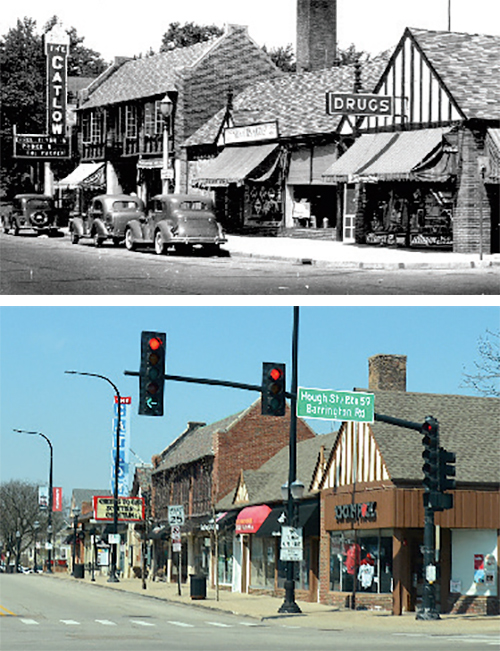Main Street Barrington is Main Street U.S.A. It is among the thousands of quintessential small town main streets that are the backbone of a continent. Direct descendants of the ancient high streets of Europe with their market squares, festivals and bandstands, their architecture and streetscapes tell stories of the past.
And so it is with Barrington, since the village was founded 165 years ago. Our Main Street is a panorama of every decade since Benjamin Felter sold his 40 acres for the railroad expansion, providing space for a train station and downtown commercial district. There is nothing cookie-cutter or master planned with Barrington architecture; it has just evolved. So many buildings are of varying scale, style, and fabric from their neighbors. Frame structures, with elements of their Greek Revival and Italianate style origins, are next door to a utilitarian postwar office building.
Start at St. Paul Church
Begin your walk at St. Paul Church, the early German church of Barrington, first built in 1863, which is across from 400 East Main Street, an ornate late Victorian residence that is now offices.
Just west, small businesses, such as The Main Place, occupy those frame houses, some dating from the 1860s.
The quirky white castle on the northeast corner of Ela Street was once Barrington’s Telephone Exchange. It faces the three-story UBS building with its straight lines, balconies, and iron railings; its construction in the 1980s caused a furor over its scale, style, and use of materials, and resulted in the creation of Barrington’s Appearance Review Committee.
In the 1980s, too, the value of historic preservation emerged in Barrington when sections of Main Street were included in the National Register Historic District. This had an impact as many property owners began to research their building renovations more carefully. On the northwest corner of Main and Ela Street, the Hollis Brothers rebuilt their office and shop using the style of the 19th century Commercial Hotel.
Historic Town Center
Across the railroad tracks is the heart of old Barrington. The junction of North and South Cook Streets, Park Avenue (it used to be Railroad Street) and Main Street was the impromptu town square, where residents gathered for news, public holidays, and festivals. A bandstand stood at the corner of Park Avenue, and nearby a three-tier drinking fountain—the top tier for horses, the middle tier for humans, and the lowest for dogs.
Today the Veteran’s Memorial commands the intersection and from its vantage point, looking west, the streetscape retains much of its early 20th century character. West of the tracks, a vernacular style brick commercial building, dating from 1898 after a major fire on the block, is missing its turret. Once George Foreman’s saloon, it has seen many uses through 120 years on the corner.
False Front Buildings
Next door, Catchpenny is a well-preserved example of false front buildings, their two-story facades concealing their single floor construction. George Stieffenhofer the blacksmith and August Jahn the wagon maker had plied their skills here. Barrington Flower Shop, a block south, is another good example of false fronts.
A state-mandated straightening of Hough Street lost the last historic store on this block, the Bob and Betty Shop at the northeast corner. But it gave us open space, where the David F. Nelson Gazebo is always surrounded by seasonal plantings.
On the south side towards Hough Street, between the more than century-old brick, two-story commercial buildings, is a touch of Tudor. In the mid-1920s, Tudor Revival residential design was translated to business districts, with gables, steeply pitched roofs, multi-paned windows, and timber cross-hatching, reminiscent of the ancient High Streets of Europe.
Tudor Style
The business district ended at Hough Street until 1925, when Wright Catlow realized his dream for a movie and vaudeville theatre, thus opening West Main Street to commercial expansion. This necessitated moving residences elsewhere, a Barrington tradition. He hired architects, Betts and Holcombe, who also used the Tudor Revival style to design the Catlow block that, with modernizing adaptations, we see today.
Residences occupied the southwest corner until 1947, when the first Jewel Tea store was built between the corner and Station Street. In the early 1950s, Jewel moved to its present site on Main Street, and relinquished the strategic corner to successive gas stations. At the beginning of the 21st century, the gas station infrastructure was demolished and the corner left vacant for future development. When, we wondered would it happen?
New Barrington Village Center
The answer came within the past six years, when new buildings, with their sidewalk dining, and a European ambience with Barrington scale and style emerged from the drawing board. We are becoming accustomed to them. In our memories, the intersection has never looked better.
Just west, nothing surprises in this streetscape like Barrington’s White House. Since it was built in 1898 by Julia and John Robertson, this grand Neo-classical residence has anchored West Main Street. And next door, the Davenport Family Funeral Home, inheritor of funeral arrangements for the community since 1861, has a low-key and dignified place in the streetscape.
A Mix of Periods and Styles
From here, west to Dundee Avenue, Main Street takes on a gentler character. The mostly late 19th century residences have become offices, and occasionally small stores. Italianate, Folk Victorian, Carpenter Gothic, American Foursquare, and Greek Revival details reveal the tastes of the original builders, and, with its lovely front garden, the Octagon House arouses our curiosity. Next door is a Foursquare, and then the circa 1925 Craftsman style bungalow claims the corner.
Barrington’s Main Street is like a crazy quilt runner, stitched together through its many ages. It has a human scale, and comfort level that says, “you can always come home again”. Barrington is unique, and it is quintessential America.
About the Author
Barbara L. Benson grew up in Kent, England, and later moved to New York. She settled in Barrington and has walked with our history ever since she first arrived here in 1980.
– End –
Share this Story

A downtown Barrington gathering on July 4, 1908. A three-tiered water fountain serves horses, people, and dogs. A bandstand can be seen on the lower right.

St. Paul United Church of Christ on East Main.

